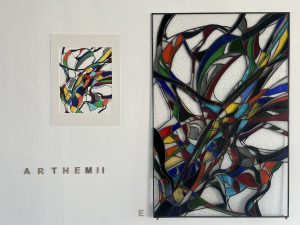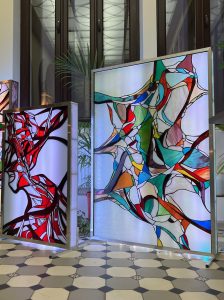Tiffany Vitrage
Stained glass works (e.g., 60×90 cm or 80×120 cm) are often installed in light boxes. These boxes provide consistent backlighting, which ensures that the colours and patterns of the glass are always visible, regardless of ambient lighting conditions. Light boxes can also be used to create specific moods by adjusting the intensity and color of the backlighting. The interaction of light and color in stained glass can evoke strong emotional responses. Warm colours might create feelings of comfort and joy, while cooler colors can induce calm and contemplation. The dynamic nature of the light effects can also stimulate the viewer’s imagination and introspection.



The Tiffany stained glass technique, also known as the copper foil method, is a classic art form perfected by Louis Comfort Tiffany in the late 19th century. This intricate process involves several steps to create beautiful, detailed glass artworks. Here’s a brief overview of how it’s done: The process begins with a detailed drawings graphics. The design is then divided into individual pieces, each representing a different section of glass. Glass Selection and Cutting: Coloured glass sheets are chosen based on the design. Each piece of the pattern is traced onto the glass and cut precisely using a glass cutter. This step requires skill to ensure the pieces fit together perfectly. Foiling: Each cut glass piece is wrapped with a thin strip of adhesive copper foil. This foil allows the pieces to be soldered together. The foil should be evenly applied to ensure a consistent look and strong bond. Assembling: The foiled pieces are carefully arranged according to the design on a work surface. They are temporarily secured in place to maintain the pattern’s integrity. Soldering: Once all the pieces are in place, they are soldered together using a soldering iron and a tin-lead solder. The solder is applied along the seams of the copper foil, bonding the glass pieces together and creating a sturdy panel. Framing and Finishing: The completed panel is then cleaned to remove any flux or residue from the soldering process. It may be framed with a rigid material, like zinc or lead came, to provide additional strength and a finished look. This technique allows for greater detail and complexity in stained glass art compared to traditional lead came methods. The Tiffany method’s ability to create intricate designs and the rich, vibrant colours of the glass contribute to its enduring popularity. Installing Stained Glass: The process of installing stained glass begins with accurately measuring the window or designated area and ensuring it is clean. The stained glass is then framed using a suitable material, such as wood, metal, or lead came. Larger panels may require support bars to prevent sagging. Once the glass is placed into the frame, it is secured and sealed with putty or silicone for stability and weatherproofing. The final step involves cleaning the glass to remove any residues and fingerprints. Light Boxes for Stained Glass: Light boxes are ideal for showcasing stained glass in spaces lacking natural light. These boxes consist of a sturdy frame, an opaque back panel, and LED lighting to provide even illumination. The LEDs, positioned behind a diffusing panel, ensure the light spreads uniformly across the stained glass. To install, the stained glass panel is mounted securely within the light box, with the LEDs connected to a power source. This setup enhances the stained glass’s visibility and adds a stunning visual element to any interior.
.
 .
.

